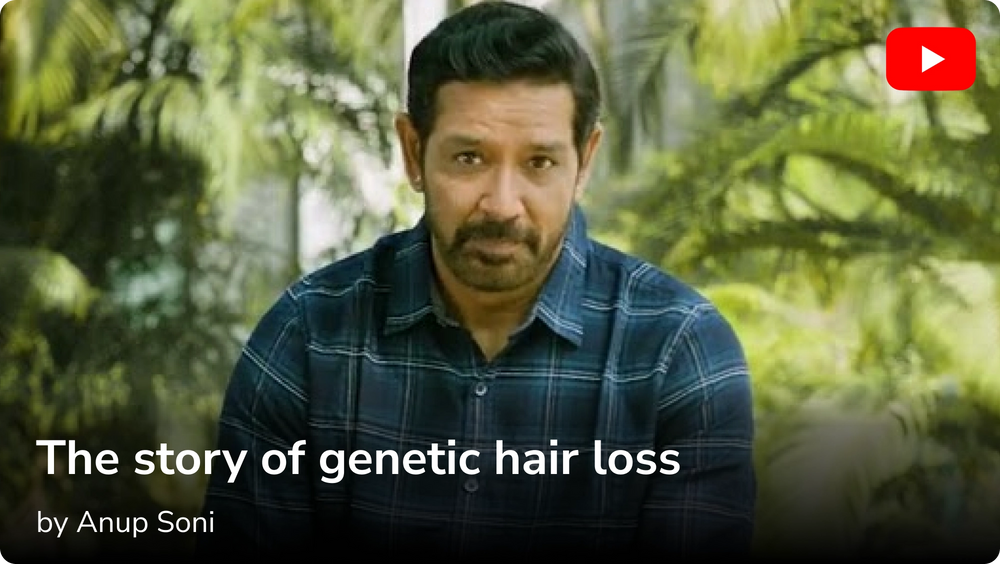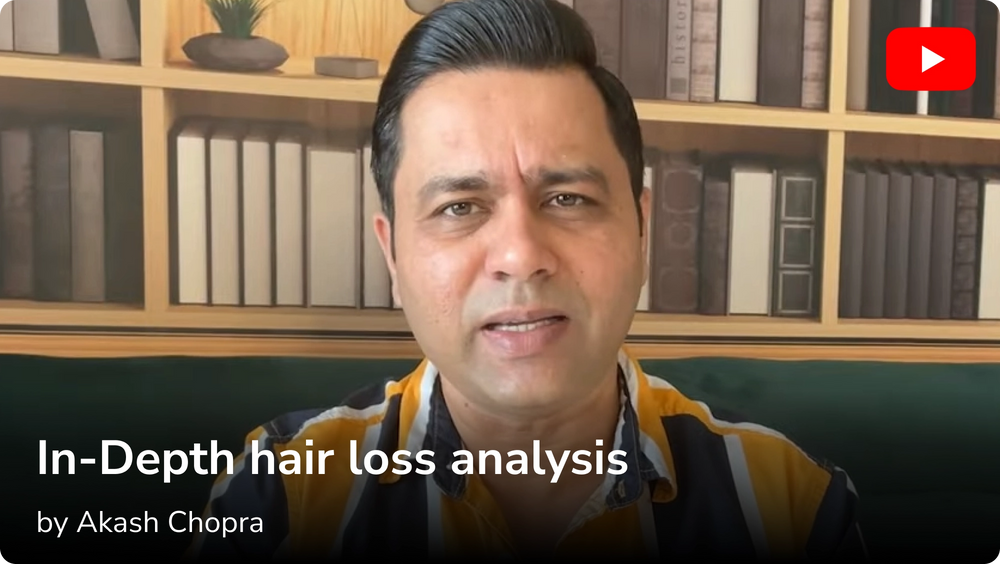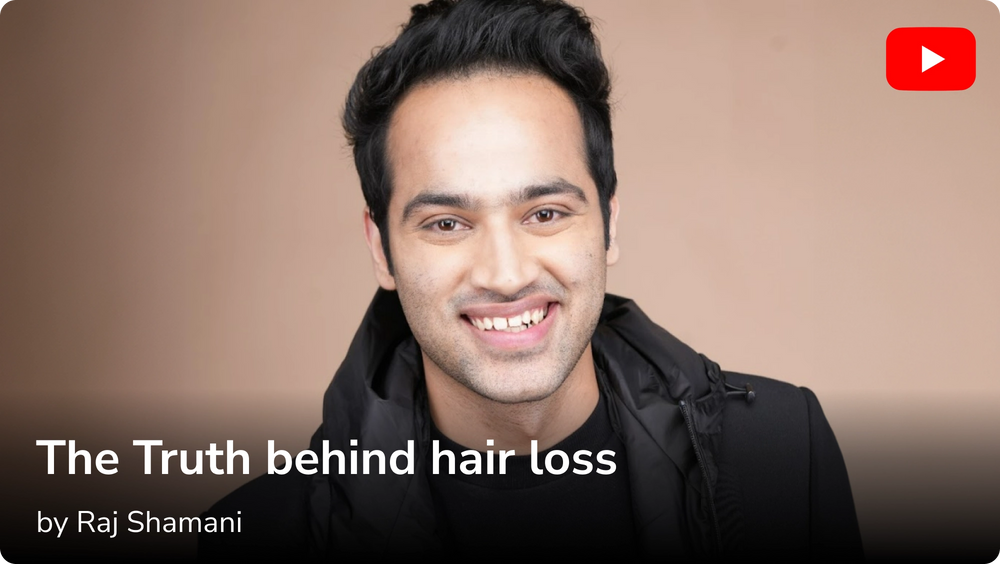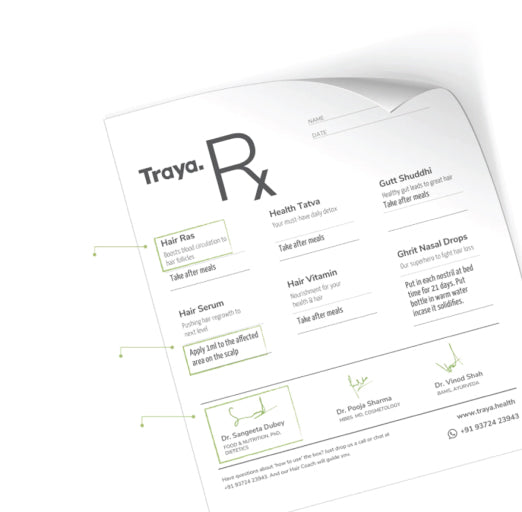What is Minoxidil?
Minoxidil is a medication that is used to treat hair loss. It dilates the blood vessels in the scalp, increasing blood flow to the hair follicles. This blood flow can stimulate hair growth. It can take several months of consistent use before results become noticeable.
Minoxidil was developed as an oral medication to manage high blood pressure. Its hair growth properties were discovered incidentally. Its vasodilating action increases nutrient and oxygen delivery to hair follicles, reviving dormant roots. Minoxidil is one of the few FDA-approved treatments for androgenic alopecia, making it a credible option
Benefits of Minoxidil Solution
Minoxidil, other than increasing hair growth, improves the texture of existing hair, making strands appear thicker and healthier. It extends the growth phase of hair. And most importantly, Minoxidil is compatible with most treatments and does not interfere with other topical solutions.
-
Hair Regrowth
Minoxidil is commonly used to treat androgenic alopecia by stimulating hair follicles, extending the anagen (growth) phase of the hair cycle, and promoting the regrowth of thicker and fuller hair. This has made minoxidil a popular choice for those suffering from hair loss. Minoxidil also increases follicular size, which helps making thicker, healthier strands.
-
Easy Application
Minoxidil solution is available in liquid form, making it easy to apply to the scalp. The solution can be applied twice a day, directly to the affected areas of the scalp using a dropper or spray applicator. This makes using minoxidil convienint and user friendly.
-
Non-Invasive Treatment
Unlike surgical hair restoration procedures, such as hair transplants, minoxidil does not require any incisions or invasive techniques. This aspect of the treatment makes it a great choice for those who prefer non-surgical treatments.
-
Over-the-Counter Availability
Another advantage of minoxidil solution is that it is over the counter in many countries. This means that individuals can purchase minoxidil without a prescription, making it easily accessible for those seeking a hair loss treatment. However it is best to consult an expert before use.
-
Versatile Use
Minoxidil solution can be used by both men and women experiencing hair loss. It treats various forms of hair loss, including male and female pattern baldness. This versatility makes it a suitable option for individuals regardless of their gender or the underlying cause of their hair loss.
-
Minimal Side Effects
When used as directed, Minoxidil solution generally has minimal side effects. The most common side effects include scalp irritation, itching, and dryness. In most cases these side effects are temporary.
-
Complementary Treatment
Minoxidil solution can be used with other hair loss treatments, such as oral medications or laser therapy. Pairing minoxidil with other tools such as derma rolling or micro needling makes the follicles even more responsive to minoxidil.
Types of Minoxidil: Which is the best?
Minoxidil is available in foam and liquid form. Each has its attributes, strengths, and weaknesses. Here's a breakdown of each type:
The choice between foam and liquid minoxidil is mostly a question of personal needs. Some people like foam because it dries faster, but others like the precision of the liquid. Dermatologists recommend that both be used before a decision is made.
Liquid Minoxidil
Liquid solutions suit people who have smaller, well-defined bald areas. Its clear nature lets you see how well it covers, which reduces product wastage.
Description
Liquid minoxidil comes in a bottle with an applicator or dropper. It is a light yellow or clear liquid you put directly on your scalp.
Alcohol and propylene glycol are utilized by liquid minoxidil to assist in delivering the active ingredient directly to the scalp.
Pros
-
Ease of Application
Liquid minoxidil allows for precise application to the affected areas of the scalp using the dropper or applicator. This can be beneficial for individuals who want to target specific areas of hair loss.
-
Wide Availability
Liquid minoxidil has been available longer and is more common in different brands and formulations.
-
Cost-Effective
Liquid minoxidil is more affordable than the foam version, making it a cost-effective option for long-term use.
Cons
If not allowed to dry thoroughly, liquid minoxidil might transfer to fabric or other parts of the body, potentially causing unintended hair growth in those areas.
-
Longer Drying Time
Liquid minoxidil may take longer to dry on the scalp. It may require extra time before styling the hair or going to bed to avoid transferring the liquid onto pillows or other surfaces.
-
Potential Scalp Irritation
Due to the alcohol content present in the solution, some users, especially those with sensitive skin, may experience scalp irritation or dryness when using liquid minoxidil.
Foam Minoxidil
Foam minoxidil is suitable for all, especially those with sensitive scalps, as its lower alcohol content makes it gentler. The foam also spreads easily over larger areas, making it convenient for users experiencing diffuse thinning.
Description
Foam minoxidil is a foam formulation that comes in an aerosol can. When dispensed, it changes from liquid to foam and is applied to the scalp
Pros
Its mess-free application makes it ideal for morning routines. Users can apply foam and style their hair soon after without worrying about residue.
-
Quick Drying
Foam minoxidil evaporates faster than the liquid formula. Foam minoxidil is easy to apply and will not make your scalp greasy or sticky, so styling your hair is easier and faster.
-
Reduced Scalp Irritation
Foam minoxidil is prepared with a lower alcohol concentration compared to the liquid version, and consequently, fewer cases of irritation or dry scalp.
-
Less Messy
Minoxidil's foam texture is more convenient to apply and prevents the product from running or dripping down the face or neck.
Cons
Some users note that the foam might not reach the scalp effectively if they have dense hair, potentially reducing absorption.
-
Limited Availability
Minoxidil foam may be slightly more difficult to get than liquid minoxidil since it is a more recent product. However, it is increasingly available since more people request it.
-
More Expensive
Foam minoxidil is generally more expensive than liquid minoxidil due to the production process. It may thus be more expensive to use in the long run.
Minoxidil Dosage for Men and Women
The recommended dose of minoxidil may vary depending on the product and formulation. However, the general recommendations for the administration of minoxidil are:
Men: In men who lose their hair, the standard treatment dose of minoxidil is a 5% solution or foam. It is usually used twice a day, with each use being 1 millilitre (ml) of solution or half a capful of foam. Read the instructions that come with the product and a doctor or nurse for advice appropriate to you.
Women: Women apply a lower concentration of minoxidil, and it is usually a 2% solution or foam. The dosage is also twice a day, with 1 ml of solution or a half capful of foam to the scalp areas that require it. Similar to men, consulting a health care provider or dermatologist is necessary for individual guidance.
Strict compliance with dosage guarantees safety and efficacy. Application of excess beyond what has been prescribed does not accelerate results and raises the risk of side effects such as dryness or irritation of the scalp.
Potential Drug Interactions with Minoxidil
Minoxidil is safe and not absorbed to any large degree when applied to the skin. However, it is advisable to be cautious of potential drug interactions. Certain drugs that can interact with minoxidil include:
Topical Treatments: Do not use minoxidil at the same time as other topical treatments on the scalp since they may alter the effectiveness of minoxidil. You should consult a health practitioner before you can use other topical treatments with minoxidil.
Medications Influencing Blood Pressure: Minoxidil reduces blood pressure, so use it cautiously when used in combination with other blood pressure-lowering medications. Examples include beta-blocker antihypertensive or calcium channel blockers. Blood pressure must be monitored when these drugs are administered.
Other Vasodilators: The administration of other vasodilators, which relax and widen the blood vessels, can boost the hypotensive (blood pressure-reducing) effect of minoxidil. Examples of such drugs are hydralazine or nitroglycerin. The combination therapy of other vasodilatory drugs must be closely monitored.
It is very crucial to make your doctor aware of all the medications you are presently taking, including over-the-counter medications and supplements, to reduce the risk of possible interactions.
It is a good idea to inform your physician of any herbal supplements you are taking, particularly those that impact blood flow, to avoid unwanted interactions. Always have a list of your medications available for your healthcare provider.
Who should not use Minoxidil?
Individuals with a known allergy or sensitivity to minoxidil or any of its components should avoid using minoxidil.
Minoxidil should not be used on a scalp with open wounds, sunburns, or other scalp abnormalities. A healthy scalp is required before starting minoxidil treatment.
The safety of minoxidil during pregnancy and breastfeeding has not been well established. It is generally recommended to avoid using minoxidil during these periods, although it is best to consult with a healthcare professional for personalized advice
Additionally, those undergoing chemotherapy or taking medications that affect skin healing should avoid minoxidil unless specifically approved by their doctor. The same caution applies to individuals with chronic skin conditions like psoriasis or eczema on the scalp.
Hair Shedding Due To Minoxidil
Using minoxidil sometimes results in an initial increase in hair shedding. Usually beginning in the first few weeks of treatment, this shedding should stop within a few weeks. This shedding is known as "minoxidil-induced shedding."
Minoxidil stimulates hair follicles to move from the resting phase (telogen) to the growth phase (anagen), thus causing shedding. Older hairs already in the shedding phase may be pushed out as new hair follicles enter the growth phase, causing more hair shedding initially. Usually, the shedding is accompanied by the development of fuller, thicker hair.
How Long Should You Use Minoxidil?
Minoxidil is a long-term treatment for hair loss, and its benefits are typically seen with continued use. The recommended duration of minoxidil use varies among individuals and may depend on factors such as the extent of hair loss, response to treatment, and personal goals. In general, it is advisable to use minoxidil consistently for at least 4 to 6 months before assessing its effectiveness. However, for optimal results, many individuals continue to use minoxidil for an extended period, often years, to maintain the benefits. Long-term commitment is essential. Dermatologists often recommend reassessing progress annually while continuing use to maintain benefits. Discontinuation should always be gradual and monitored.
What Happens When You Stop Using Minoxidil?
Androgenic alopecia, also known as male/female pattern baldness, is a manageable condition that can be prevented by taking control of your hair loss condition at the appropriate time. After years of research, doctors have determined that minoxidil is safe for long-term use, so if you want to stop using it for your hair and are concerned about side effects, you should read on. If you want to stop using minoxidil solution for your hair, you should gradually reduce the frequency of application. You can consider alternatives like redensyl, procapil, or capixyl.
Abruptly stopping use can cause hair loss by shocking the follicles back into their dormant state. The effects of stopping minoxidil can be lessened by switching to alternative therapies like peptides or plant-based serums.
How To Apply Minoxidil on Hair?
Here's a general guide on how to apply minoxidil
-
Before using minoxidil, make sure your scalp is dry and clean.
-
Apply 1 ml (or as prescribed) of liquid minoxidil directly to the scalp's afflicted areas using a dropper or spray applicator. Apply half a capful of foam minoxidil to your fingers and then to the afflicted areas if you're using it.
-
To guarantee uniform distribution and absorption, gently massage the minoxidil foam or solution into the scalp.
-
To avoid transferring the minoxidil to pillows or other surfaces, let it completely dry before styling your hair or going to bed.
-
After using minoxidil, wash your hands well to prevent accidental contact with other body parts.
Can Minoxidil Help Grow New Hair?
It has been proven that minoxidil aids in hair growth. Minoxidil increases blood flow to the scalp, prolongs the anagen (growth) phase of the hair cycle, and stimulates hair follicles. In areas impacted by androgenic alopecia (male and female pattern baldness), this may result in the regrowth of fuller, thicker hair. It's important to remember that each person will experience hair regrowth to varying degrees, and that it might take several months of regular use before any noticeable effects appear.
Minoxidil is most useful for preserving existing hair and reviving dormant follicles, but it has also demonstrated promise in promoting the growth of vellus hairs, or fine baby hairs, which will eventually develop into thicker terminal strands.
Best Minoxidil Product In India
In India, Traya is well-known for offering one of the best minoxidil serums. With a 5% concentration for men and a 2% concentration for women, our expertly made minoxidil serums efficiently meet the needs of each individual. Quality and client satisfaction are our top priorities. By stimulating hair follicles, the minoxidil serum encourages the growth of fuller, thicker hair.
The safety and effectiveness of Traya's minoxidil formulations are guaranteed by their development in collaboration with dermatologists. By minimising irritation and optimising outcomes, the addition of scalp-nourishing ingredients helps sustain scalp health throughout your hair regrowth journey.
Takeaway
Minoxidil is safe, FDA-approved, and effective in treating androgenic alopecia. However, be sure to take it as directed by a physician and in the recommended dosage. Take the hair test with Traya right now to learn more about your hair loss condition and the side effects of minoxidil.
Minoxidil is most effective when used in combination with other hair care products. Its effectiveness can be greatly increased by combining it with customised diet plans, stress-reduction strategies, and routine scalp care. To get the most out of your hair regrowth journey, start early, be consistent, and be patient.
FAQs
Can minoxidil regrow hair?
Yes, by stimulating hair follicles and encouraging hair growth, minoxidil can aid in hair regrowth for a large number of people.
Can minoxidil treat pattern hair loss?
Yes, minoxidil is frequently used to treat androgenic alopecia, or pattern hair loss, in both men and women.
Is it safe to use minoxidil?
When used as directed, minoxidil is considered safe. However, some individuals may experience scalp irritation or other side effects. It is important to follow the instructions and consult with a healthcare professional if any concerns arise.
Can I stop minoxidil after 1 month?
For best effects, minoxidil should be taken regularly for a long time. Since hair regrowth may not be apparent for several months, it is not advised to discontinue minoxidil use after just one month.
Can women use minoxidil for hair growth?
Minoxidil is safe for women to use to promote hair growth. For women, certain formulations with a lower minoxidil concentration (2%) are advised. For individualised counsel and direction, speaking with a healthcare expert is advised.
Does minoxidil thicken existing hair strands?
Yes, minoxidil improves the size and health of hair follicles, leading to thicker and stronger hair strands.
Can I apply minoxidil before bedtime?
Yes, just ensure it dries fully before lying down to prevent the solution from transferring to your pillow.
Should I wash my hair daily while using minoxidil?
Not necessarily. Keeping your scalp clean is important, but daily washing isn’t mandatory. Just ensure it’s clean and dry before each application.
References
-
Microneedling with 5% minoxidil helps treat androgenetic alopecia] -https://www.semanticscholar.org
-
Better results were obtained with a combination of topical minoxidil with finasteride than with plain topical minoxidil. https://www.semanticscholar.org




















